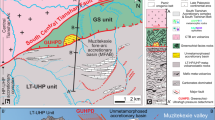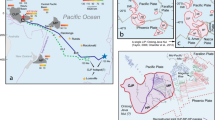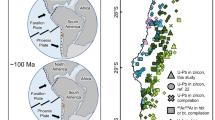Abstract
According to the theory of plate tectonics, rocks found in the vicinity of mid-ocean ridges — where oceanic plates are created — should be relatively young (at most several Myr old). Here we report the discovery of zircons with ages of about 330 and 1,600 Myr that were drilled from exposed gabbros beneath the Mid-Atlantic Ridge near the Kane fracture zone1,2,3,4. Age determinations were made using the 207Pb/206Pb evaporation method5 and confirmed with conventional U–Pb dating and ion microprobe (SHRIMP) analysis. We suggest two plausible explanations for the origin of these unusually old zircons. During the opening of the Atlantic, sheared crustal material or delaminated continental lithosphere sank into small roll-like circulation cells6,7 that developed in the shallow mantle at each side of the ridge axis and the material was then transported through these cells to the ridge axis. Alternatively, material from the continental crust has been trapped within the Kane fracture zone since the opening of the Atlantic Ocean basin through a series of transform migrations and ridge jumps8,9, with portions of this material subsequently migrating down the ridge axis.
This is a preview of subscription content, access via your institution
Access options
Subscribe to this journal
Receive 51 print issues and online access
$199.00 per year
only $3.90 per issue
Buy this article
- Purchase on Springer Link
- Instant access to full article PDF
Prices may be subject to local taxes which are calculated during checkout




Similar content being viewed by others
References
Cannat, M. & ODP shipboard Scientific Party Leg 153 Probing the foundation of the Mid-Atlantic Ridge. Eos 76, 129–133 (1995).
Werner, C.-D. Data report: geochemistry of rocks and minerals of the gabbro complex from the MARK area. Proc. ODP Sci. Res. 153, 491–504 (1997).
Werner, C.-D. & Pilot, J. Data report: geochemistry and mineral chemistry of ultramafic rocks from the Kane area (MARK). Proc. ODP Sci. Res. 153, 457–470 (1997).
Pilot, J., Werner, C.-D. & Tichomirow, W. Further oxygen isotope investigations from an ultramafic profile, hole 920D: alterations by seawater. Terra Nostra 4, 66 (1996).
Kober, B. Single-zircon evaporation combined with Pb+ emitter bedding for 207Pb/206Pb-age determinations using thermal ion mass spectrometry, and implications to zirconology. Contrib. Mineral. Petrol. 96, 63–71 (1987).
Nicolas, A. Die Ozeanischen Rücken 140, Fig. 7.7 (Springer, Berlin, (1995)).
Rabinowicz, M., Nicolas, A. & Vigneresse, J. L. Arolling mill effect in asthenosphere beneath oceanic spreading centers. Earth Planet. Sci. Lett. 67, 97–108 (1984).
Bonatti, E. & Crane, K. Oscillatory spreading explanation of anomalously old uplifted crust near oceanic transforms. Nature 300, 343–345 (1982).
Kepezhinskas, P. & Dmitiev, D. Continental lithospheric blocks in central Atlantic Ocean. Ofioliti 17, 19–35 (1992).
Cannat, M., Bideau, D. & Bougault, H. Serpentinized peridotites and gabbros in the Mid-Atlantic Ridge axial valley at 15° 37′ N and 16° 52′ N. Earth Planet. Sci. Lett. 109, 87–106 (1992).
Karson, J. A. & Winters, A. T. in Ophiolites and their Modern Oceanic Analogues (eds Parsons, L. M., Murton, B. J. & Browning, P.) 107–116 (Spec. Publ. 60, Geol. Soc., Boulder, (1992)).
Pupin, J. P. Zircon and granite petrology. Contrib. Mineral. Petrol. 73, 207–220 (1980).
Gaggero, L. & Gazzotti, M. Primary and secondary oxides, sulfides and accessory minerals in Mid-Atlantic gabbros: mineralogy and petrology. Ofioliti 21, 105–116 (1996).
Kelley, D. S. & Malpas, J. Melt-fluid evolution in gabbroic rocks from Hess Deep. Proc. ODP Sci. Res. 147, 213–226 (1996).
Cannat, M., Ceuleneer, G., Fletscher, J. Localization of ductile strain and the magmatic evolution of gabbroic rocks drilled at the Mid-Atlantic Ridge (23° N). Proc. ODP Sci. Res. 153, 84 (1997).
Tera, F. & Wasserburg, G. J. U-Th-Pb systematics in lunar highland samples from the Luna 20 and Apollo 16 mission. Earth Planet. Sci. Lett. 17, 36–51 (1972).
Wendt, I. Radiometric methods in Geochronology. Clausthaler Tektonische Hefte 23, 92–96 (1986). (In German.)
Ludwig, K. R. Effect of initial radioactive-daughter disequilibrium on U-Pb isotope apparent ages of young minerals. J. Res. US Geol. Surv. 5, 663–667 (1977).
Wendt, I. & Carl, C. U/Pb dating of discordant 0.1 Ma old secondary U minerals. Earth Planet. Sci. Lett. 73, 278–284 (1985).
Metzger, K. & Krogstad, E. J. Interpretation of discordant U-Pb zircon ages: an evaluation. J. Metamorphic Geol. 15, 127–140 (1997).
Lee, J. K. W., Williams, I. S. & Ellis, D. J. Pb, U, and Th diffusion in natural zircon. Nature 390, 159–162 (1997).
Kresten, P., Fels, P. & Berggren, G. Kimberlitic zircons — a possible aid in prospecting for kimberlites. Mineral. Deposita (Berl.) 10, 47–56 (1975).
Ahrens, L. H., Cherry, R. D. & Erlank, A. J. Observations on the relationship in zircons from granitic rocks and from kimberlites. Geochim. Cosmochim. Acta 31, 2379–2387 (1967).
Kinny, P. D., Compston, J., Bristow, J. W. & Williams, I. S. in Kimberlites and Related Rocks Vol. 2(eds Ross, J. et al.) 833–842 (Geol. Soc. Austr. Spec. Publ. 14, Blackwell, Melbourne, (1989)).
Jochum, K. P., Hofmann, A. W., Ito, E., Seufert, H. M. & White, W. M. K, U and Th in mid-ocean ridge basalt glasses and heat production, K/U and K/RB in the mantle. Nature 306, 431–436 (1983).
Hofman, A. W. Chemical differentiation of the Earth: the relationship between mantle, continental crust, and oceanic crust. Earth Planet. Sci. Lett. 90, 297–314 (1988).
Chen, Y. D., O'Reilley, S. Y., Kinny, P. D. & Griffin, W. L. Dating lower crust and upper mantle events: an ion microprobe study from kimberlitic pipes, South Australia. Lithos 32, 77–94 (1994).
Bonatti, E. et al. Lower Cretaceous deposits trapped near the equatorial Mid-Atlantic Ridge. Nature 380, 518–520 (1996).
Beljatsky, B. V. et al. Precambrian granitic gneiss from MAR (26° N): results of U-Pb and Sm-Nd-isotopic investigations. Geomija 8, 876–880 (1997). (In Russian.)
Truchalev, A. I. et al. Old K-Ar-age of an metagabbro and a granite-gneiss dredged at the axial part of the Mid-Atlantic Ridge, 26° N. Dokl. Akad. Nauk 311, 1447–1452 (1990). (In Russian.)
White, R. & McKenzie, D. Magmatism at rift zones: the generation of volcanic continental margins and flood basalts. J. Geophys. Res. 94(6), 7685–7729 (1989).
Tucholke, B. E. & Schouten, H. Kane fracture zone. Mar. Geophys. Res. 10, 1–39 (1988).
Ludwig, K. R. ISOPLOT — a Plotting and Regression Program for Radiogenic-Isotope DataV2.71 (Open File Rep. 91-445, US Geol. Surv., Denver, (1992)).
Cannat, M. et al. Ultramafic and gabbroic exposures at the Mid-Atlantic Ridge: geological mapping in the 15°N region. Tectonophysics 279, 193–213 (1997).
York, D. Least squares fitting of a straight line with correlated errors. Earth Planet. Sci. Lett. 5, 320–324 (1969).
Acknowledgements
We thank P. Herzig and S. Petersen for comments; A. W. Hofmann, B. Hanan, F. Tera and S. Uhlig for discussions; U. Kempe for help with the SEM images; W. Todt (MPI Mainz) for supporting the conventional U-Pb dating; and I. S. Williams (ANU, RSES, Canberra) for SHRIMP datings. This work was supported by the Deutsche Forschungsgemeinschaft.
Author information
Authors and Affiliations
Corresponding author
Rights and permissions
About this article
Cite this article
Pilot, J., Werner, CD., Haubrich, F. et al. Palaeozoic and Proterozoic zircons from the Mid-Atlantic Ridge. Nature 393, 676–679 (1998). https://doi.org/10.1038/31452
Received:
Accepted:
Issue Date:
DOI: https://doi.org/10.1038/31452
This article is cited by
-
Radiation damage allows identification of truly inherited zircon
Communications Earth & Environment (2022)
-
Phase equilibrium modeling of zircon stability in mantle peridotite: Implication for crust-mantle interaction
Science China Earth Sciences (2022)
-
Zircon Xenocrysts from the Shaka Ridge Record Ancient Continental Crust: New U-Pb Geochronological and Oxygen Isotopic Data
Journal of Earth Science (2022)
-
The phanerozoic palaeotectonics of Turkey. Part I: an inventory
Mediterranean Geoscience Reviews (2019)
-
Experimental evidence for the preservation of U-Pb isotope ratios in mantle-recycled crustal zircon grains
Scientific Reports (2018)
Comments
By submitting a comment you agree to abide by our Terms and Community Guidelines. If you find something abusive or that does not comply with our terms or guidelines please flag it as inappropriate.



